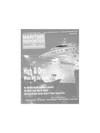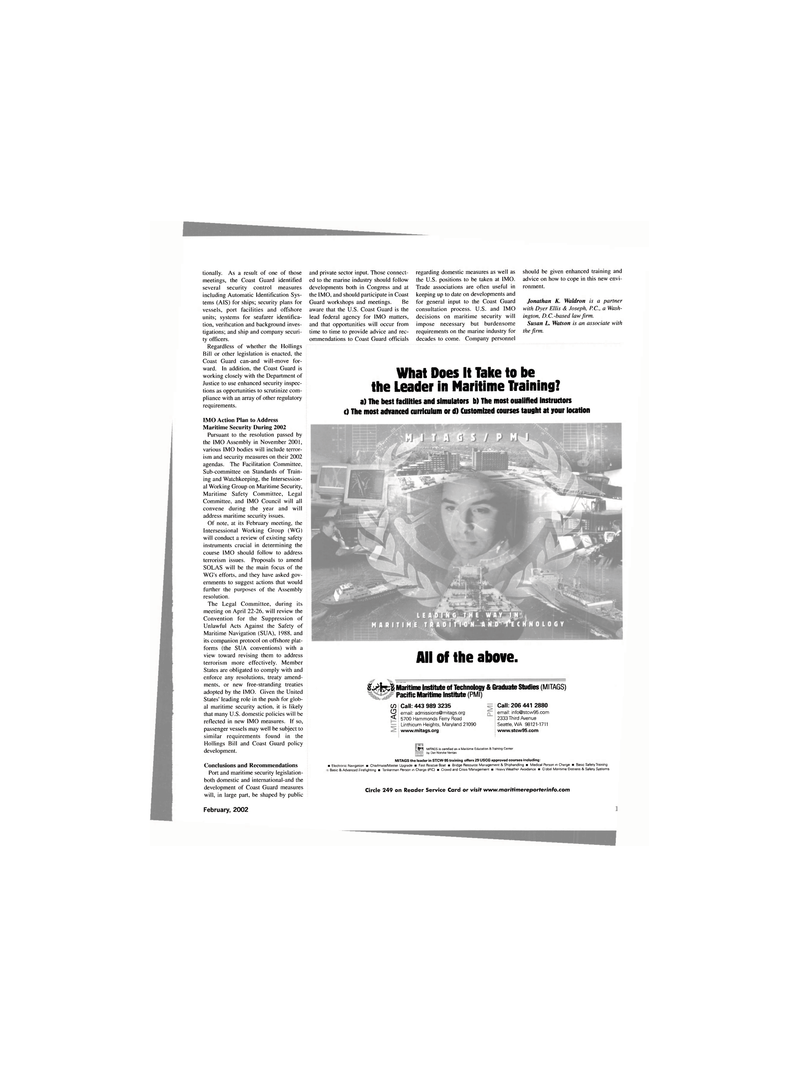
Page 11: of Maritime Reporter Magazine (February 2002)
Read this page in Pdf, Flash or Html5 edition of February 2002 Maritime Reporter Magazine
tionally. As a result of one of those meetings, the Coast Guard identified several security control measures including Automatic Identification Sys- tems (AIS) for ships; security plans for vessels, port facilities and offshore units; systems for seafarer identifica- tion, verification and background inves- tigations; and ship and company securi- ty officers.
Regardless of whether the Hollings
Bill or other legislation is enacted, the
Coast Guard can-and will-move for- ward. In addition, the Coast Guard is working closely with the Department of
Justice to use enhanced security inspec- tions as opportunities to scrutinize com- pliance with an array of other regulatory requirements.
IMO Action Plan to Address
Maritime Security During 2002
Pursuant to the resolution passed by the IMO Assembly in November 2001, various IMO bodies will include terror- ism and security measures on their 2002 agendas. The Facilitation Committee,
Sub-committee on Standards of Train- ing and Watchkeeping, the Intersession- al Working Group on Maritime Security,
Maritime Safety Committee, Legal
Committee, and IMO Council will all convene during the year and will address maritime security issues.
Of note, at its February meeting, the
Intersessional Working Group (WG) will conduct a review of existing safety instruments crucial in determining the course IMO should follow to address terrorism issues. Proposals to amend
SOLAS will be the main focus of the
WG's efforts, and they have asked gov- ernments to suggest actions that would further the purposes of the Assembly resolution.
The Legal Committee, during its meeting on April 22-26. will review the
Convention for the Suppression of
Unlawful Acts Against the Safety of
Maritime Navigation (SUA), 1988, and its companion protocol on offshore plat- forms (the SUA conventions) with a view toward revising them to address terrorism more effectively. Member
States are obligated to comply with and enforce any resolutions, treaty amend- ments, or new free-stranding treaties adopted by the IMO. Given the United
States' leading role in the push for glob- al maritime security action, it is likely that many U.S. domestic policies will be reflected in new IMO measures. If so, passenger vessels may well be subject to similar requirements found in the
Hollings Bill and Coast Guard policy development.
Conclusions and Recommendations
Port and maritime security legislation- both domestic and international-and the development of Coast Guard measures will, in large part, be shaped by public and private sector input. Those connect- ed to the marine industry should follow developments both in Congress and at the IMO, and should participate in Coast
Guard workshops and meetings. Be aware that the U.S. Coast Guard is the lead federal agency for IMO matters, and that opportunities will occur from time to time to provide advice and rec- ommendations to Coast Guard officials regarding domestic measures as well as the U.S. positions to be taken at IMO.
Trade associations are often useful in keeping up to date on developments and for general input to the Coast Guard consultation process. U.S. and IMO decisions on maritime security will impose necessary but burdensome requirements on the marine industry for decades to come. Company personnel should be given enhanced training and advice on how to cope in this new envi- ronment.
Jonathan K. Waldron is a partner with Dyer Ellis & Joseph, P.C., a Wash- ington, D.C. -based law firm.
Susan L. Watson is an associate with the firm.
What Does It Take to be the Leader in Maritime Training? a) The best facilities and simulators M The most oualifled instructors c) The most advanced curriculum or d) Customized courses taught at your location
All of the above.
Ofca Maritime institute of Technology & Graduate Studies (MITAGS)
Pacific Maritime Institute (PMI)
CO o <
Call: 443 989 3235 email: [email protected] 5700 Hammonds Ferry Road
Linthioum Heights, Maryland 21090 www.mitags.org
Call: 206 441 2880 email: [email protected] 2333 Third Avenue
Seattle, WA 98121-1711 www.stcw95.com lyV MITAGS is certified as a Maritime Education & Training Center by Det Norske Veritas
MITAGS the leader in STCW-95 training offers 29 USCG approved courses including: • Electronic Navigation • Chiefmate/Master Upgrade • Fast Rescue Boat • Bridge Resource Management & Shiphandling • Medical Person in Charge • Basic Safety Training i Basic & Advanced Firefighting • Tankerman Person in Charge (PIC) • Crowd and Crisis Management • Heavy Weather Avoidance • Global Maritime Distress & Safety Systems
Circle 249 on Reader Service Card or visit www.maritimereporterinfo.com
February, 2002 13

 10
10

 12
12
